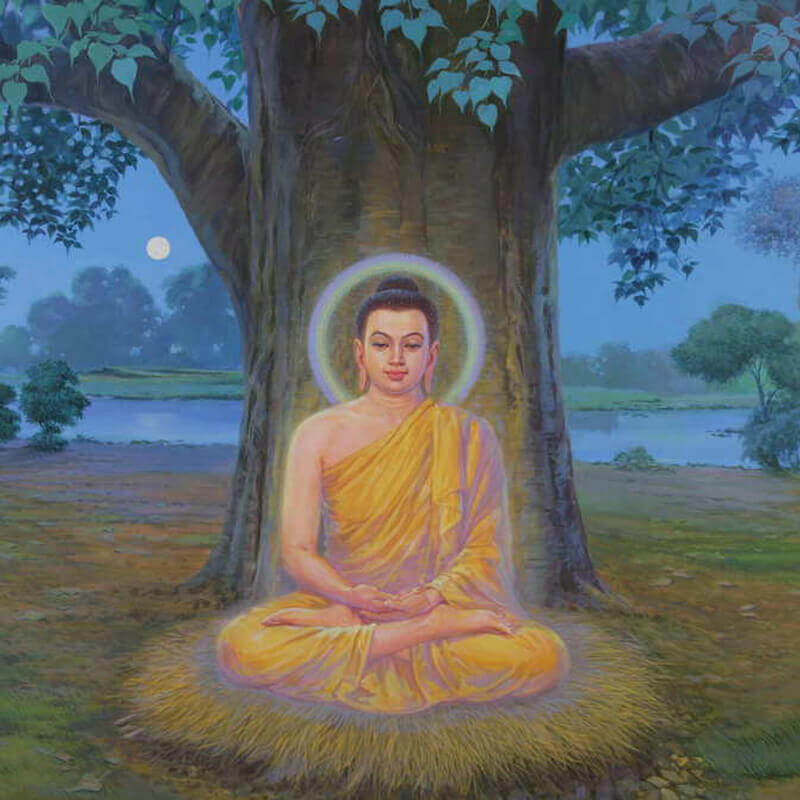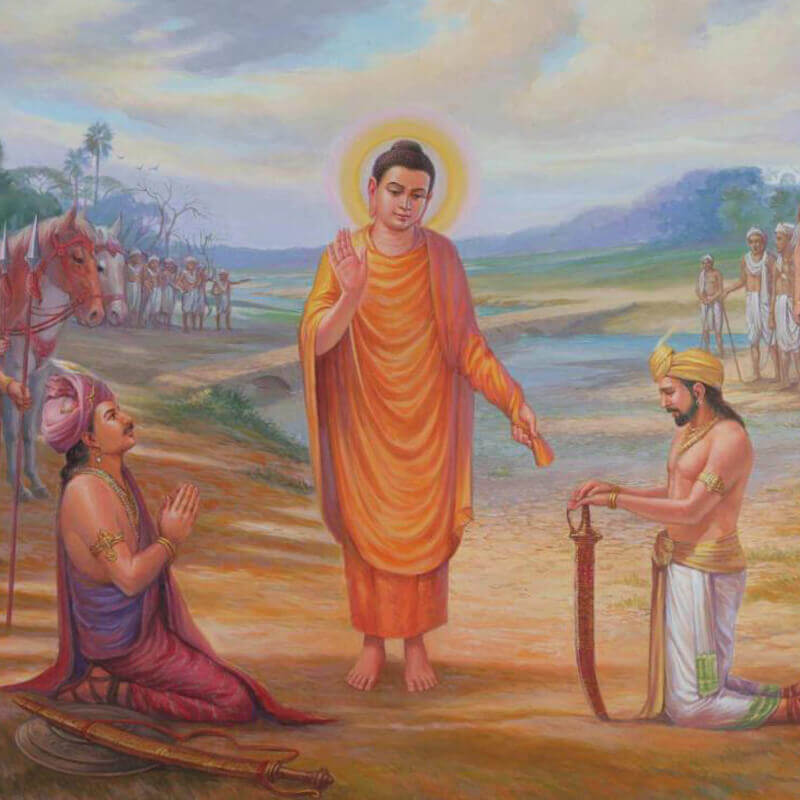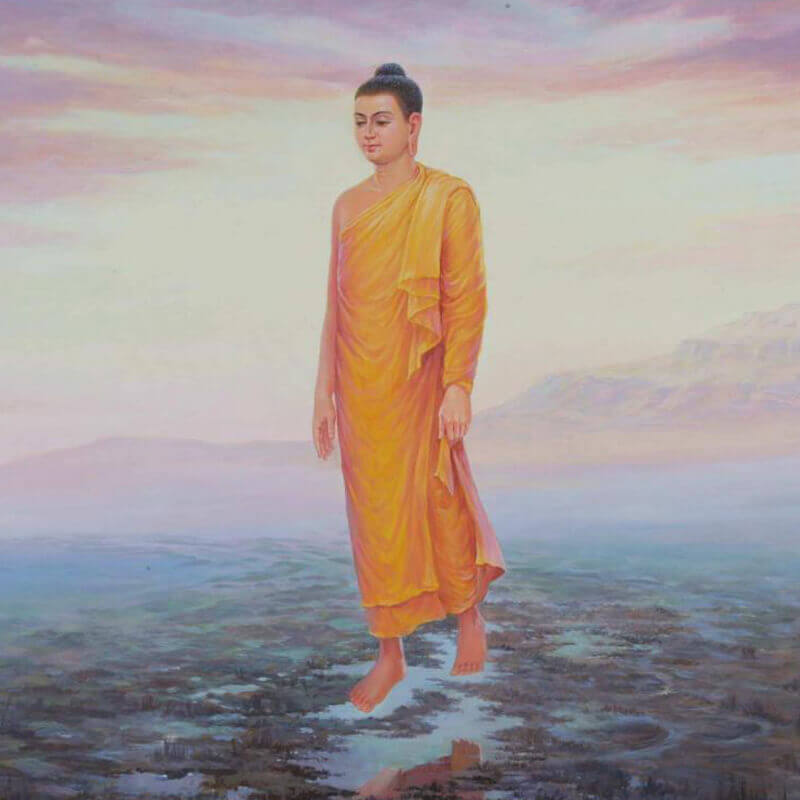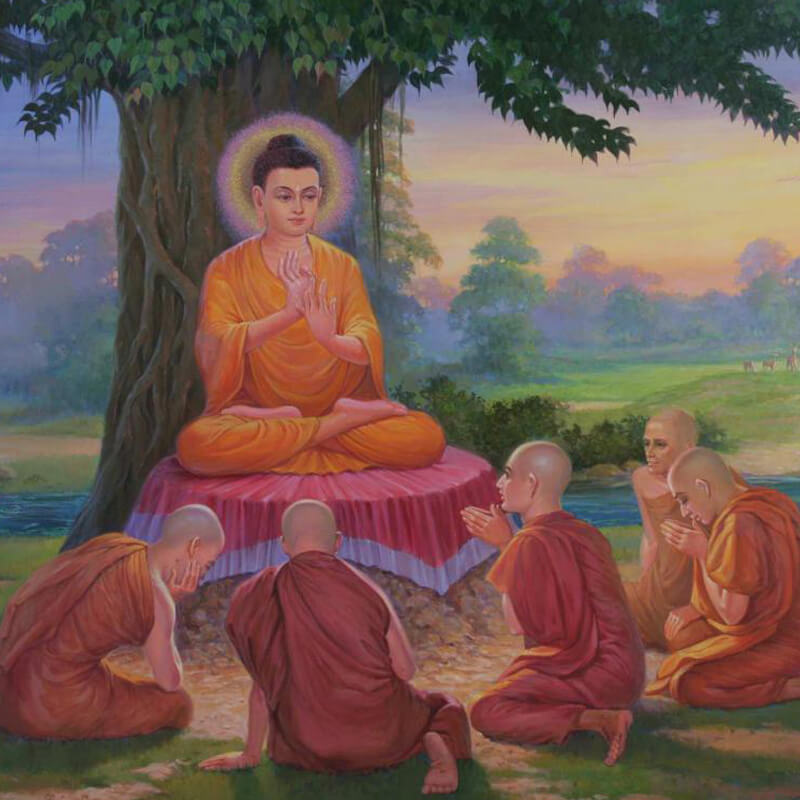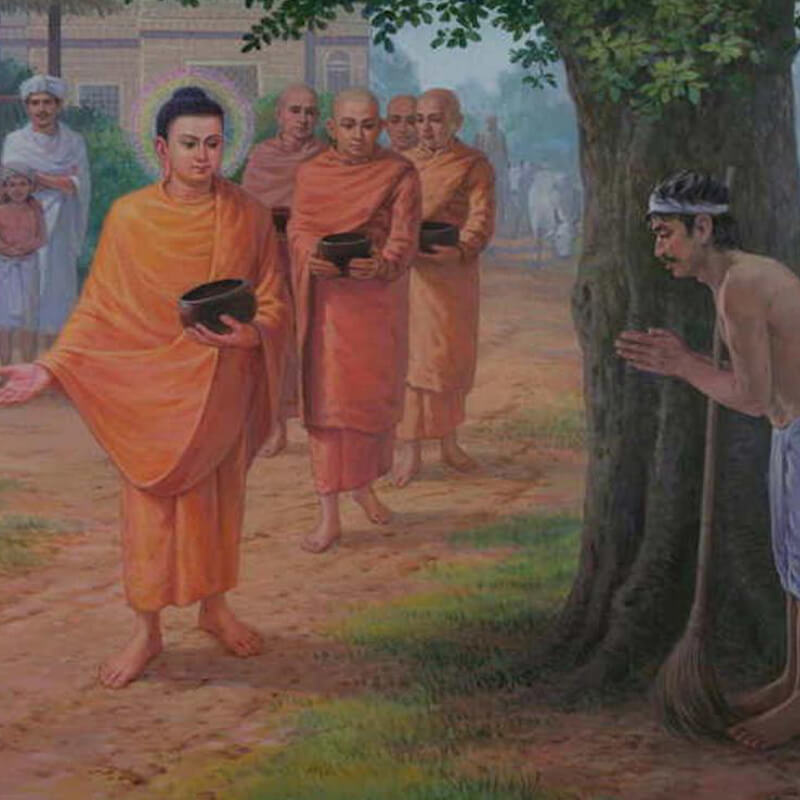It is reported that two kingdoms were on the verge of war for the possession of a certain embankment which was disputed by them.
And the Buddha, seeing the kings and their armies ready to fight, requested them to tell him the cause of their quarrels. Having heard the complaints on both sides, he said:
“I understand that the embankment has value for some of your people; has it any intrinsic value aside from its service to your men?”
“It has no intrinsic value whatever,” was the reply. The Tathagata continued: “Now when you go to battle, is it not sure that many of your men will be slain and that you yourselves, O kings, are liable to lose your lives?”
And they said: “Verily it is sure that many will be slain and our own lives be jeopardized.”
“The blood of men, however,” said Buddha, “has it less intrinsic value than a mound of earth?”
“No,” the kings said, “the lives of men and above all the lives of kings, are priceless.”
Then the Tathagata concluded: “Are going to stake that which is priceless against that which has no intrinsic value whatsoever?”
The wrath of the two monarchs abated, and they came to a peaceable agreement.
— The Gospel of Buddha
(Courtesy: International Vipassana Newsletter, Winter 1982)
* * * * * * * * * * * * * * * * * * * * * * * * * * * * * * * * * * * * * * * * * * * * * * * * * * * * * * * * * * * * * * * * * *
The Sakyan and Koliyan republics were established on the opposite banks of the Rohiṇī river. The members of the ruling assembly in these two republics were called rājās and the chief of the rājās was called mahārājā. They had autonomy over all domestic administrative matters. However, they were not fully independent states like Vesālī because both were vassal states of the neighbouring kingdom of Kosala.
The Sakyans and the Koliyans were both khattiyas of the Ādicca (Ikśvāku) clan of the solar dynasty. There was no other royal khattiya family equal to them in the region, and therefore, members of the royal families of these two republics married only among themselves. Both clans were very proud of the purity of their royal blood and had practised this tradition of inter-marriage since ancient times. For example, Suddhodana’s paternal aunt was married to the Koliyan ruler Anjana. Their daughters, Mahāmāyā and Mahāpajāpati Gotamī, were married to Suddhodhana, the chief of the Sakyans. Similarly, Yashodhara, daughter of Suppabuddha, who was Anjana’s son, was married to the Sakyan prince, Siddhattha. Thus, the two royal families were related by marriage bonds between maternal and paternal cousins since ancient times.
In spite of such close blood-ties, there would be occasional rifts between the two royal families, which sometimes turned into open hostility.
The traditional occupation of both clans was agriculture. The lowlands of the Tarāī province at the foothills of the mightyHimalayas were very fertile. The Rohiṇī river brought abundant water from the Himalayas and irrigated the agricultural lands of both republics. Therefore, the people in both republics were very prosperous.
Initially, as the population in both the Sakyan and the Koliyan states was low, the water of the Rohiṇī was adequate for their farms. However, with the passage of time, the surrounding forestlands were converted into agricultural land to meet the increasing needs of the growing population. The river water was no longer sufficient to meet the increased demand. This scarcity of water soon became a cause of conflict between the two republics.
People on both sides of the riverbank blamed each other for taking excessive water from the river. They would make new water-sharing agreements, which were then repeatedly violated.
As the population continued to grow, the land under cultivation also increased and the Koliyans and the Sakyans could barely get enough water from the upper Rohiṇī for their needs. The Rohiṇī had very little water by the time it reached the capitals of the Sakyans and the Koliyans. Although both republics had built a dam across the river together, the water level in it was very low in summer.
A crisis developed during the lifetime of the Buddha. It was the month of May. The water level of the river was very low. Fields on both sides of the river were scorched by the summer heat. Without sufficient water, the crops would be destroyed. There was so little water left in the dam that it could irrigate the farms only on one side of the river; the crops on the other side were bound to perish.
If the water in the dam were shared equally, the crops on both sides of the river would wither because of the inadequate water supply. If all the water were used to irrigate the fields on one side, at least those crops could be saved.
Therefore, the Sakyan and the Koliyan farm labourers met to discuss the sharing of the meagre water in the reservoir. Each side insisted that their crops be saved and the cultivators from the other side should ask for a share of the harvest. The labourers on both sides were too proud to ask for a share from the other side. Soon, the arguments became more heated. The situation deteriorated to an exchange of verbal abuse and then to an exchange of blows. The labourers of both sides insulted the masters of one another and then abused the ancestors of the ruling clans.
Some labourers reported the exchange of these abuses to the owners of the farms. Upon hearing about the insults to their ancestors, the mutual hostility between the two agricultural communities increased.
The quarrel reached the Sakyan and Koliyan ministers, and then the princes and the kings. When the youthful princes on both sides heard the description of the abuses against their ancestors, they flew into a rage and vowed to avenge the insults to their ancestors. Inflamed with anger, they gathered on their respective riverbanks, fully armed, and challenged the other side to fight. The situation was grim and the possibility of bloodshed seemed imminent.
When the Buddha learned about this outbreak of hostility, he came there himself. On seeing this revered and eminent person from their royal clan, the warriors of both sides became deeply embarrassed. All of them laid down their weapons and paid homage to him. This was the traditional way of paying respects to the Buddha in those days.
Whenever King Pasenadi of Kosala went to pay respects to the Buddha, he would leave the royal insignia such as his sword, turban, fan, parasol and sandals outside with his attendant before entering the chamber of the Buddha.
The Buddha took the seat prepared for him on the open ground of the riverbank. The Sakyans and the Koliyans paid homage to the Buddha and sat respectfully on one side before him. The Buddha explained to them that their blood was much more valuable than the river-water. They should not spill blood unnecessarily. Instead, they should find a way to share the water peacefully. The Buddha was a peacemaker filled with compassion. He did not consider it proper that human life should be lost for the sake of trivial material gains.
-Sutta Nipāta Aṭṭhakathā 2.362, Sammāparibbājanīyasuttavaṇṇanā
* * * * * * * * * * * * * * * * * * * * * * * * * * * * * * * * * * * * * * * * * * * * * * * * * * * * * * * * * * * * * * * * * *
Compared to the powerful neighbouring kingdom of Kosala, both the Sakyan and Koliyan republics were extremely weak. They had surrendered their sovereignty to Kosala. Due to mutual discord, there was the possibility that they would lose their internal autonomy too.
If the Sakyans and Koliyans fought against each other, both would be destroyed. If they were united, both would be strengthened by their combined might. The ruler of Kosala would not be able to stretch them further on the rack of his supremacy. However if they remained united, it is quite possible that they may even be able to free themselves completely from the dominance of Kosala. Keeping this in mind, the Buddha gave them the teaching on the benefits of maintaining unity.
The Buddha discerned that the conflict had intensified because of misunderstanding. The labourers working in the fields had abused the ancestors of the rājās of the other side. But the rājās were informed that the other rājās had abused their ancestors. If it had been made clear to the rājās from both sides that irresponsible farm labourers were at fault, they would have reprimanded their own labourers and the matter would have ended there; the situation would not have reached the brink of bloodshed. Both republics would have remained united.
With this situation in mind, the Buddha narrated a Jataka story. Sometimes, it is easier to clarify matters with the help of a story. Therefore, he narrated the Duddubha Jataka to illustrate how an ignorant being harms itself by becoming a victim of blind belief. The wise, however, investigate the truth and save themselves from harm.
Duddubha Jataka
According to this Jataka, a hare was resting under a wood-apple tree. Suddenly a ripe wood-apple fruit fell on the ground nearby. The hare heard the sound of the fruit hitting the ground and panicked. It thought that the sky had split and the earth was breaking up. Terror-stricken, it fled from the spot. It told all the animals that it met on the way that the sky had split and the earth was breaking up. All the other animals such as other hares, deer, pigs, antelopes, buffaloes, bulls, tigers, and elephants that heard this, blindly believed it and started to flee in panic. In their terror-stricken flight, all of them would have plunged into the ocean in front of the forest and drowned.
class="page-wrap"
When the lion, the king of the jungle, saw this danger, it stopped the stampeding animals and admonished them. It said, "Come, let us go to the spot where the hare heard the sound of the earth breaking up." All the animals went with the hare to the tree where it had been resting. When they saw the fallen wood-apple fruit, they realised the truth and were greatly relieved.
When one blindly believes rumours and reacts without thinking, one causes great harm. Expressing this, the Buddha said:
Appatvā padaviññāṇaṃ, paraghosānusārino;
Panādaparamā bālā, te honti parapattiyā
-Jātaka 1.4.322, Duddubha Jātaka
Without knowing the truth oneself, one who heeds the statements of others and follows them out of blind belief is a careless fool.
The Buddha explained that by the time the mutual abuse of the foolish farm labourers had reached the farm-owners, the ministers, the nobles, the rājās and the hot-headed princes, they had all been misled and were prepared to destroy themselves. If they had calmly examined the facts, they would have rebuked their labourers and ended the quarrel immediately.

